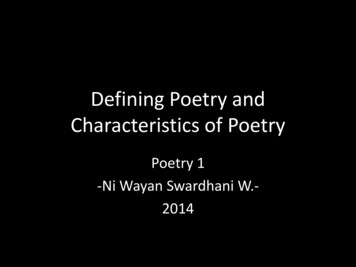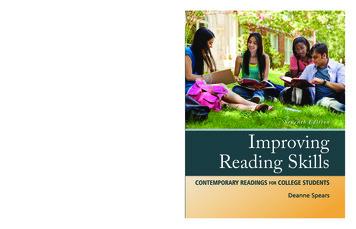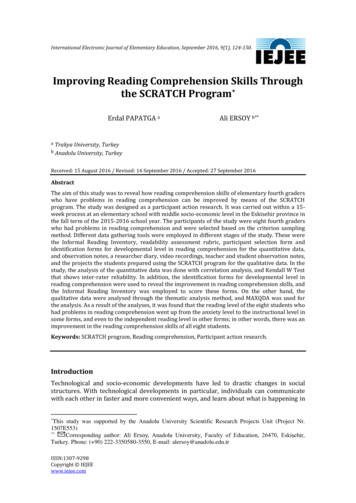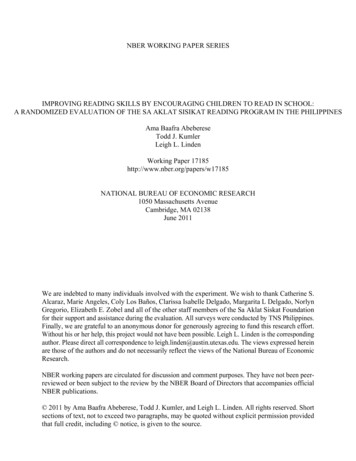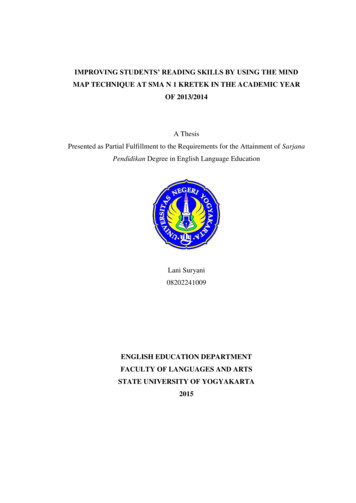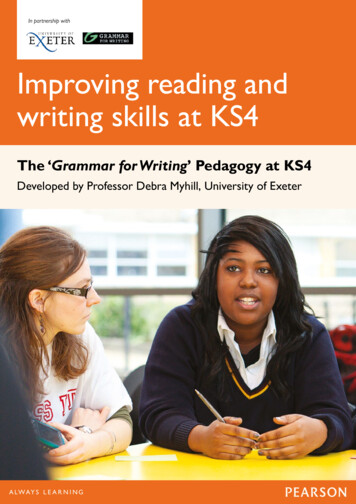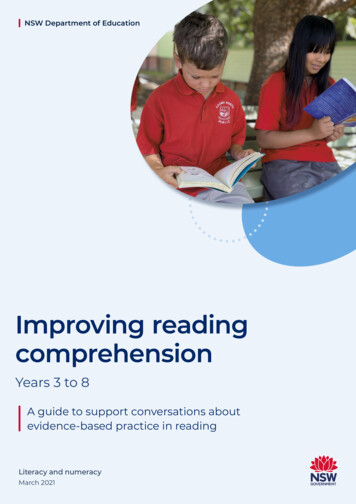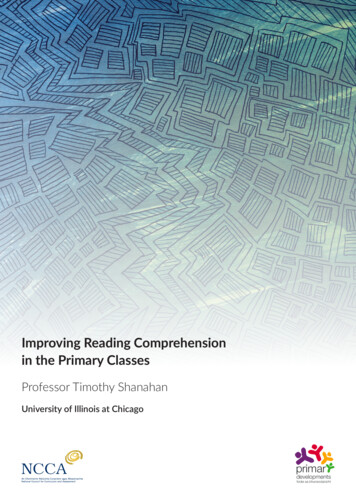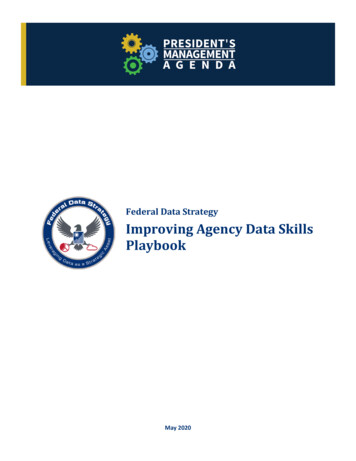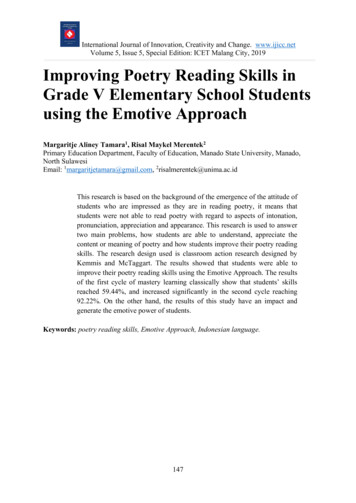
Transcription
International Journal of Innovation, Creativity and Change. www.ijicc.netVolume 5, Issue 5, Special Edition: ICET Malang City, 2019Improving Poetry Reading Skills inGrade V Elementary School Studentsusing the Emotive ApproachMargaritje Aliney Tamara1, Risal Maykel Merentek2Primary Education Department, Faculty of Education, Manado State University, Manado,North SulawesiEmail: 1margaritjetamara@gmail.com, 2risalmerentek@unima.ac.idThis research is based on the background of the emergence of the attitude ofstudents who are impressed as they are in reading poetry, it means thatstudents were not able to read poetry with regard to aspects of intonation,pronunciation, appreciation and appearance. This research is used to answertwo main problems, how students are able to understand, appreciate thecontent or meaning of poetry and how students improve their poetry readingskills. The research design used is classroom action research designed byKemmis and McTaggart. The results showed that students were able toimprove their poetry reading skills using the Emotive Approach. The resultsof the first cycle of mastery learning classically show that students’ skillsreached 59.44%, and increased significantly in the second cycle reaching92.22%. On the other hand, the results of this study have an impact andgenerate the emotive power of students.Keywords: poetry reading skills, Emotive Approach, Indonesian language.147
International Journal of Innovation, Creativity and Change. www.ijicc.netVolume 5, Issue 5, Special Edition: ICET Malang City, 2019INTRODUCTIONThe more humans develop, the greater the development of science and technology in all fields(Brookfield, 2015; Dunleavy & Dede, 2014; Smith, 2016). This requires education to adjust itssteps to remain relevant so as not to lag behind. The development of humanity pushes moreand more people forward and does not want to be left behind. They all need better education(Arthur & Carr, 2013; Smith, 2016). As a result, both the quality and quantity of educationcannot be ignored. Learning is an activity that involves a person in an effort to obtainknowledge, skills and, positive values by utilising it as a source for learning in elementaryschools which is currently growing rapidly, from traditional learning to modern learningsystems (Alderman, 2013). Learning activities are no longer just teaching but more complexand carried out with diverse learning patterns (Ellis, 2017).Indonesian language learning is directed at increasing the ability of students to communicatein Indonesian language properly and correctly, both verbally and in writing, and to fosterappreciation for the results of Indonesian human literary work (Saddhono, 2017; Stracke, 2016;Suparsa, Mantra, & Widiastuti, 2017). Indonesian is one of the five innovative lessons taughtin elementary schools, because Indonesian has a position and function that are very importantfor everyday life. The purpose of learning Indonesian language means that students have goodand correct Indonesian language skills and can live Indonesian language and literature inaccordance with the situation and purpose of language and the level of experience ofelementary school students (Akhadiah Sabarti, n.d.; Frazier & Brown, 2001).In general, the functions and objectives of learning Indonesian language and literature are as ameans of: (1) fostering national unity; (2) enhancing knowledge and skills in the context ofcultural preservation and development; (3) increasing knowledge in order to gain and developscience, engineering, and art; (4) dissemination of Indonesian language and literature learningfor various purposes; (5) development and reasoning; and (6) understanding the diversity ofIndonesian culture through Indonesian literary treasures (Kwall, 2015; Markov & Egle, 2019).There are a number of reasons why researchers make increasing poetry reading skills to study(Dahliana, 2019; Nichols, Rasinski, Rupley, Kellogg, & Paige, 2018; Satinem & Juwati, 2018).The main reason is the ability of fifth grade students of SD GMIM XV Manado has not shownsatisfactory and maximum results in improving poetry reading skills. The students areimpressed as they are in reading poetry, meaning that it is not seen that students are able to readpoetry by paying attention to aspects of intonation, pronunciation, appreciation and appearance.Rarely seen are students who read poetry with attention to the ups and downs, highs and lows,soft volume in the reading. No students of their own will appear in front of the class to readpoetry. The result is students read poetry as they please and do not mean it.147
International Journal of Innovation, Creativity and Change. www.ijicc.netVolume 5, Issue 5, Special Edition: ICET Malang City, 2019Training students in poetry reading is very important (Hanauer, 2017). Poetry reading activitiesare not only used to sharpen observation and improve language skills (Fahrurrozi, 2018;Firman, 2018). With poetry reading activities students are expected to gain fresh interest thatarises from the depth of the poem itself (Guy, 2015). Learning to read poetry does not have tobe used to print, learning to read poetry can be used to express thoughts and feelings. Learningto read poetry can also be used to develop students' creativity (Hanauer, 2017).Poetry is one of the learning materials from learning Indonesian. Poetry is a form of literaturethat expresses thoughts and feelings imaginatively and is compiled by concentrating all thepower of language by concentrating the physical structure and inner structure. In a poem, thepoet devotes all his feelings and thoughts which are then processed by using the poet's creativityand manifested through the medium of language (Goodman, 2018). The language used inpoetry is different from the language used in drama and fiction (Hinchliffe, 2017; Short, 2018).The language used in poetry tends to be distinctive because the poet wants to express his soulin a dense and intense manner (Nichols et al., 2018; Timmermans & Johnson, 2017). For that,poets use diction, denotative and connotative meanings, figurative language, imagery,rhetorical means, linguistic factors and things related to the structure of words or sentences intheir poetry (Dahliana, 2019; Hanauer, 2017).In language lessons, one of the materials that must be understood by students is reading poetry.In line with this, that reading poetry is an activity of reading literary works that use beautifuland meaningful words (Lou & Noels, 2019; Satinem & Juwati, 2018). So, reading poetry isreading written information using beautiful and meaningful words. Therefore, there are severalskills that must be mastered by students in order to be able to read poetry well. Skills in readingpoetry include (Audina, Slamet, & Poerwanti, 2018; Chortaria & Zafiri, 2018): First, it isnecessary to understand the intent and content of poetry in order to appreciate it. Second,understanding poetry content both happy, scared, sad, etc. so that it can be expressed throughfacial expressions. Third, understanding the punctuation contained in the poem, for example:punctuation (/) means pausing, punctuation (//) means stopping a little longer. Fourth, able toarticulate / pronounce clearly when the poem is read. Fifth, able to adjust the tone ofpronunciation when reading poetry.One of the learning approaches that can be used in order to improve poetry reading skills is inthe fifth grade students of the elementary school is namely Emotive Approaches (Lin, Chew,& Chen, 2017). This approach involves emotions which teach to read poetry with the righttechniques to stimulate the feelings, visions, hearing and pronunciation of students so that theyseem to be in or in the environment that the poem tells. Thus, they can feel sad, happy, difficultand so on according to the one described by poetry (Hanauer, 2017; Satinem & Juwati, 2018).The Emotive Approach is an approach to the appreciation of literary works by finding elementsthat suggest the emotions and feelings of the reader (Tajri & Chandra, 2018; Yacoub, 2018).148
International Journal of Innovation, Creativity and Change. www.ijicc.netVolume 5, Issue 5, Special Edition: ICET Malang City, 2019Giving emotion can be in the form of beauty or something new that can entertain connoisseursof literature; or even about funny and interesting ideas or ideas contained in literary works thatthey enjoy. Imaginative Emotive Approach is an approach that tries to find the elements thatsuggest the emotions or feelings of the reader (Cowie & Hanrott, 2018). Asking emotions isrelated to the beauty of the presentation of forms and suggestions that relate to content or ideasthat are funny or interesting (Canfield, 2016).Therefore through this Emotive Approach can optimise the right brain hemisphere so thatstudents can develop their imagination freely. The brain is a sleeping giant. Balanced use ofthe right and left brain can lead to reading well. This positive effect of working the righthemisphere is stimulation or encouragement for the work of the left hemisphere so that at thesame time students can develop their logic, which in the end students can produce good poeticworks (Fakhri & Faujiyah, 2019).METHODOLOGYThis research is a classroom action research with descriptive method that is implemented inteaching and learning activities in the classroom. This class action research was designed byKemmis and Mc Taggart, which consists of four stages, namely: (1) Planning Phase; (2)Actions; (3) Observation; (4) Reflection (Williams, 2011).This classroom action research was conducted on fifth grade students of elementary schoolGMIM XV Manado. Why class V students? Because they are already in the concreteoperational stage, where children are able to think logically and able to solve concrete problemsand take initiatives through classifying, identifying, interpreting and applying learningconcepts.Data collection techniques, which will be used in this study consist of observations (a way toconduct an assessment by conducting direct and systematic observations) and tests (a series ofquestions or exercises or other tools used to measure skills, knowledge, intelligence, ability ortalent possessed by individuals or groups).Data analysis techniques in this study include techniques for analysing qualitative data andquantitative data. Qualitative data analysis shows the selection of data (data reduction) that isrelevant to the purpose of improving learning, describing observational data, and drawingconclusions regarding the use of Emotive Approaches, to improve the ability to read poetry inlearning Indonesian. Quantitative data in the form of simple numbers, includes the test scoresas a result of students' poetry reading abilities in Indonesian language learning and the resultsof observations of activities of teacher and student activities.149
International Journal of Innovation, Creativity and Change. www.ijicc.netVolume 5, Issue 5, Special Edition: ICET Malang City, 2019If all the indicators set out in the poetry reading ability of students in Indonesian languagelearning have met the minimum completeness criteria reaching a minimum average score of65 (the score set by the school on Indonesian language lessons) and the number of studentswho have completed the study reaching a minimum of 65% in a classical manner, it can beinterpreted that the results of the poetry reading ability of class V students has increased. Ifstudents get a value of 65 then they are categorised as complete learning; but if students get avalue of 65 then it is categorised as not yet complete learning. The complete analysis ofclassical learning is using �� �𝑖𝑖𝐹𝐹𝐹𝐹𝐹𝐹𝐹𝐹𝐹𝐹 𝑆𝑆𝑆𝑆𝑆𝑆𝑆𝑆𝑆𝑆 𝑥𝑥 100%𝑆𝑆𝑆𝑆𝑆𝑆𝑆𝑆𝑆𝑆 ��𝑀RESULTS AND DISCUSSIONCycle ISome things deserve appreciation that the students entrusted by the teacher recite poetry in thegroup. They were able to answer the challenge even though it felt scary at first because thestudents still felt embarrassed to read poetry. With the character of the different students thereis a challenge for the teacher, because there are still students who are difficult to be invited topay attention to learning because they may still be familiar with the previous learning process.Students were quite surprised by the presentation of the video delivered, so that at the firstmeeting the class atmosphere became crowded and tended to be noisy.At the second meetingthe students were not surprised anymore but they were already getting used to the learningprocess.On the other hand students are still having difficulties with the process of giving input to theprocess of reading poetry by their friends, this possibility is because in the previous learningprocess students never do things like this. Despite the difficulties, the teacher was guided sothat they began to get used to the learning process. It appears that the quality of learningdisplayed by teachers and students in the learning process by using an Emotive Approach, hasnot been satisfactory, so it needs to be continued and then improved in the next cycle. Basedon the steps of learning Indonesian with an Emotive Approach that has been designed byresearchers, the reality in the field shows that there are still many shortcomings made byteachers, where there are still several steps in the Emotive Approach that the teacher does notdo. Similarly, student activities in the learning process have not been satisfactory. Somestudents are less enthusiastic, joking and not diligent in the learning process.150
International Journal of Innovation, Creativity and Change. www.ijicc.netVolume 5, Issue 5, Special Edition: ICET Malang City, 2019Table 1. Results of Reading Skills Achievement in Class V Students Elementary Schoolin Cycle IAspects of Poetry Reading SkillsNameResp 1Resp 2Resp 3Resp 4Resp 5Resp 6Resp 7Resp 8Resp 9Numberof StudentTotalSigns ofPoetryReadingPurposeMimics of IntonationandPronunciatio Value InformatioPoetryof ReadingnContents teIn the calculation of learning completeness above the researcher sums all the correct answersand values of all students, divided by the number of all students and multiplied by 100%, thenthe percentage analysis of student learning success in classics obtained in the first cycle onlyreaches 59.44% with a success rate students who complete learning only 3 students out of 9students or 33.33% students who achieve a minimum score of 65 as specified in the minimumcompleteness criteria.Based on the learning outcomes of students' poetry reading skills during the learning processhas not been achieved; because most students are less directed to logical, objective andanalytical thinking in the learning process discussed. In general, it can be concluded that theuse of the Emotive Approach has not been implemented properly and maximally and willcontinue in the next cycle.Cycle IIBased on the observations of researchers, in general an overview of the course of teaching andlearning activities is as follows: Teachers carry out poetry reading learning activities inaccordance with the learning design that has been made. When the teacher delivers the material,151
International Journal of Innovation, Creativity and Change. www.ijicc.netVolume 5, Issue 5, Special Edition: ICET Malang City, 2019most students seem to pay more attention to the teacher. Although, there are still some studentswho are less serious about paying attention (first meeting), and this does not happen at thesecond meeting. In this second cycle the teacher asks students to look at poetry readingsdirectly. From these activities students can appreciate the contents of the poem presented. Inthis second cycle of action the teacher when giving material is often interspersed with questionsand answers. In addition, in the middle of learning the teacher also provides an interlude byinviting students to be more relaxed so that students also look more enthusiastic and enjoy thelesson.The existence of rewards from the teacher in the form of praise, applause, added value, andgifts turned out to be quite effective in increasing students to express their opinions, andresponding to statements or stimulus given by the teacher. All students are invited to activelyapperception together so that almost all students concentrate and focus on learning. In this cyclethe teacher also conducts poetry reading lessons well and increasingly shows an increase,especially in classroom management and applying the Emotive Approach. The teacher alsorepeated the material given at the previous meeting. Furthermore, the initial activity of learningbegins with the teacher's explanation of the sequence of words collected from students and canbe transformed into a poem. The response and interaction of students and teachers at this stageis very good. Students are very happy at the time of making poetry because the poem is theresult of their thoughts and is proud of their class making a poem together. The students lookedso enthusiastic, this was seen during the appointment of students who wanted to read poetry,almost all students pointed their hands to be able to come forward.As long as the learning activities take place at this stage and all students follow them well, theinteraction, activity, and response of students to the teacher is going to improve. It can be saidthat shortcomings or weaknesses during the implementation of the action in the second cycleare barely visible or have been as expected. Table 2 shows that the teacher has been able toovercome the shortcomings that occurred well in the previous two cycles. In addition, in thiscycle the attitude of students in learning also looks better.152
International Journal of Innovation, Creativity and Change. www.ijicc.netVolume 5, Issue 5, Special Edition: ICET Malang City, 2019Table 2. Results of Reading Skills Achievement in Class V Students Elementary Schoolin Cycle IIAspects of Poetry Reading SkillsPurposeSigns ofMimics of IntonationandPronunciatioNumber ofPoetryPoetryof ReadingValue InformationnContents ofRespondentReadingReadingPoetryPoetryResp 1Resp 2Resp 3Resp 4Resp 5Resp 6Resp 7Resp 8Resp 9Number ofStudentTotal entageAn increase in the classical average value indicates that the score of students' listening skillimproved. In addition, increasing the value of students also has a positive impact on increasingthe number of students who complete the study. Where the total number of students totaling 9students have completed their studies or 100% of the students have completed. While theincrease in mastery learning classically can be seen from the increase in the percentage ofstudents who have completed. Where the learning outcomes in this second cycle all studentssucceeded in completing the learning outcomes well so as to produce a percentage of learningcompleteness in the classical amounting to 92.22%.In accordance with the criteria of the results of the expected intervention action, the researchaction using an Emotive Approach, to improve poetry reading skills at the end of cycle II hasreached mastery learning (100%), so that the action is not continued again in the next cycle.DISCUSSIONThe increase in the results of the learning process in order to improve poetry reading skillsoccurs because researchers assisted by classroom teachers are able to evaluate properly andcorrectly all the problems in the learning process starting from the initial research and theimplementation of the first cycle to the implementation of the second cycle. The process ofimplementing learning in each cycle is carried out in two meetings (Chortaria & Zafiri, 2018;Firman, 2018). This is done so that the students are able to absorb the new learning model well153
International Journal of Innovation, Creativity and Change. www.ijicc.netVolume 5, Issue 5, Special Edition: ICET Malang City, 2019and are able to apply it to the test results of learning carried out at the end of the cycleimplementation at the second meeting of each cycle.The process of implementing learning can be done by the teacher well, this can be seen fromthe activity of students. This is possible because the teacher acts as a facilitator who can guidestudents, so students are active and motivated to plan and do learning, brave and free to arguewith logical reasons, conduct learning activities, and ask questions and draw conclusions(Damaianti, Damaianti, & Mulyati, 2017). On the other hand, students have shown respect forthe teacher because they are given the trust and opportunity for them to actively participate, sothat an interactive learning process occurs (Frazier & Brown, 2001).The Emotive Approach is able to change the state of learning with fun activities (Schonfeld etal., 2015; Yacoub, 2018). This happens because the application of reading learning with anEmotive Approach has advantages in contributing to improving reading skills. Emotive powergeneration of students given through additional learning media can stimulate and conditionstudents in such a way that students can provide positive responses.On the other hand the Emotive Approach connects what the teacher will teach with an event,thought, or feeling gained from home life, social life outside the home, and academic life ownedby the students. On the other hand, the Emotive Approach is an approach to reading learningby giving stimuli to arouse emotions or feelings possessed by students so that they can createimaginatively (Damaianti et al., 2017; Guy, 2015; Saepurokhman, 2016). Other learning mediafunction as creators of emotive atmospheres, stimulus, and at the same time a bridge forstudents to imagine or create images and events or events based on impressions displayed infront of the class (Muya & Kagaoan, 2017; Wahyuddin, Ridwan, & Martono, 2019). Theexpected response arises from the students in the form of the ability to see the images of theincident with imagination and logic that is owned and then re-express using verbal symbols.Therefore, through this Emotive Approach it can optimise the right brain hemisphere so thatstudents can develop their imagination freely (Brinton & Fujiki, 2017). The balanced use ofthe right and left brain can read well (Saepurokhman, 2016). This positive effect of workingthe right hemisphere is stimulation or encouragement for the work of the left hemisphere sothat at the same time students can develop their logic, which in the end students can producegood poetic works.CONCLUSIONThe use of the Emotive Approach in the process of learning Indonesian can improve the poetryreading skills of fifth grade students of SD GMIM XV Manado. This is evident in this study,where in the first cycle classical learning completeness reached 59.44% with the number ofstudents completing learning and only 2 students from 9 class V students or around 22.22%.154
International Journal of Innovation, Creativity and Change. www.ijicc.netVolume 5, Issue 5, Special Edition: ICET Malang City, 2019While the results achieved in cycle II increased significantly where the completeness oflearning in classics reached 92.22% with the number of students who have completed reached100%. Students are advised to participate in learning activities that should be more active andtake lessons feeling happy. This is because with the presence of pleasure in students it willfoster students' curiosity towards the material being studied and make it easier for students toexplore the material.155
International Journal of Innovation, Creativity and Change. www.ijicc.netVolume 5, Issue 5, Special Edition: ICET Malang City, 2019REFERENCEAkhadiah Sabarti. (n.d.). Menulis.Alderman, M. K. (2013). Motivation for achievement: Possibilities for teaching and learning.Routledge.Arthur, J., & Carr, D. (2013). Character in learning for life: a virtue-ethical rationale forrecent research on moral and values education. Journal of Beliefs & Values, 34(1),26–35.Audina, R., Slamet, S. Y., & Poerwanti, J. I. S. (2018). THE EFFECT OF LEARNINGMODEL PICTURE AND PICTURE AND READING INTEREST TOWARDSTUDENTS’ POETRY WRITING SKILLS OF 5TH GRADE PRIMARY SCHOOLSTUDENTS. Social, Humanities, and Educational Studies (SHEs): ConferenceSeries, Vol. 1. https://doi.org/10.20961/shes.v1i1.23656Brinton, B., & Fujiki, M. (2017). The power of stories: Facilitating social communication inchildren with limited language abilities. School Psychology International, 38(5), 523–540.Brookfield, S. D. (2015). The skillful teacher: On technique, trust, and responsiveness in theclassroom. John Wiley & Sons.Canfield, D. W. (2016). The Discursive Construction of Language Teaching and Learning inMultiuser Virtual Environments.Chortaria, S., & Zafiri, M.-N. (2018). IMPROVING THE READING AND SPEAKINGSKILLS OF A2 LEVEL STUDENTS IN A PRIVATE LANGUAGE INSTITUTEBASED ON THE COMMUNICATIVE LANGUAGE TEACHING APPROACH.INTED2018 Proceedings. https://doi.org/10.21125/inted.2018.0715Cowie, H., & Hanrott, H. (2018). The Writing Community: A Case Study of One JuniorSchool Class. The Development of Children’s Imaginative Writing, pp. Dahliana, D. (2019). The Effect of Mind Mapping Technique on Poetry Writing SkillsElementary School Students. International Journal of Educational Dynamics, Vol. 1,pp. 286–294. https://doi.org/10.24036/ijeds.v1i1.5Damaianti, V. S., Damaianti, L. F., & Mulyati, Y. (2017). Cultural Literacy Based CriticalReading Teaching Material with Active Readerstrategy for Junior High School.International Journal of Evaluation and Research in Education (IJERE), Vol. 6, p.312. https://doi.org/10.11591/ijere.v6i4.10775Dunleavy, M., & Dede, C. (2014). Augmented reality teaching and learning. In Handbook ofresearch on educational communications and technology (pp. 735–745). Springer.Ellis, A. K. (2017). I Learned. Teaching, Learning, & Assessment Together, pp. rrozi, D. (2018). THE DEVELOPMENT OF ASSESSMENT MODEL OF EARLYSTAGE READING ABILITY BASED ON THE WHOLE LANGUAGELEARNING AT THE FIRST GRADE ELEMENTARY SCHOOL STUDENTS IN156
International Journal of Innovation, Creativity and Change. www.ijicc.netVolume 5, Issue 5, Special Edition: ICET Malang City, 2019DKI JAKARTA PROVINCE. PONTE International Scientific Researchs Journal,Vol. 74. https://doi.org/10.21506/j.ponte.2018.1.12Fakhri, F., & Faujiyah, P. Y. (2019). Social Emotional Learning in Increasing the SocialEmotional and Academic Development of Children in Early Childhood Education.6th International Conference on Educational Research and Innovation (ICERI 2018).Atlantis Press.Firman, F.-. (2018). INCREASING SKILLS READING STUDENTS THROUGH GUIDANCEAND COUNSELING CLASSICAL USING CTL ier, S., & Brown, H. D. (2001). Teaching by Principles: An Interactive Approach toLanguage Pedagogy. TESOL Quarterly, 35(2), 341. https://doi.org/10.2307/3587655Goodman, L. (2018). Notes of an Apprentice: Non-Existent Facts―Poetry Reading andDiscussion. 현대영미시연구, 24(2), 201–232.Guy, P. (2015). Transforming Reading Skills in the Secondary r, D. I. (2017). Poetry Reading and Group Discussion in Elementary School. TalkingTexts, pp. 363–379. , A. P. (2017). Modern verse drama. Routledge.Kwall, R. R. (2015). Culture, Law, and the Development of Jewish Tradition. The Myth of theCultural Jew, pp. 1–28. 03.0002Lin, I.-H., Chew, S. W., & Chen, N.-S. (2017). A Vocal Assessment Approach to MeasureElementary School Students’ Critical Thinking Skills. 2017 IEEE 17th InternationalConference on Advanced Learning Technologies (ICALT).https://doi.org/10.1109/icalt.2017.30Lou, N. M., & Noels, K. A. (2019). Promoting growth in foreign and second languageeducation: A research agenda for mindsets in language learning and teaching. System,86, 102126. , V. I., & Egle, L. Y. (2019). CULTURAL ASPECTS OF THE STUDY OFREGIONAL MUSICAL TRADITION. Bulletin of Kemerovo State University ofCulture and Arts, pp. 106–115. Muya, G. R., & Kagaoan, M. A. C. P. (2017). Assessment of Media Literacy Campaign forGrade 4 Pupils at a Public Elementary School in the Philippines. RedesigningLearning for Greater Social Impact, pp. 289–299. https://doi.org/10.1007/978-98110-4223-2 27Nichols, W. D., Rasinski, T. V., Rupley, W. H., Kellogg, R. A., & Paige, D. D. (2018). WhyPoetry for Reading Instruction? Because It Works! The Reading Teacher, 72(3), 389–397.Saddhono, K. (2017). The argumentative writing skill with multicultural awareness inindonesian language for foreign learners.Saepurokhman, A. (2016). Improvement of the Elementary School Students’ ReadingComprehension through Generative Learning Model (A Quasi-Experimental Study on157
International Journal of Innovation, Creativity and Change. www.ijicc.netVolume 5, Issue 5, Special Edition: ICET Malang City, 2019Reading Learning Model of the Elementary School Students at Subdistrict SouthSumedang, Sumedang Regency). Al-Tsaqafa: Jurnal Ilmiah Peradaban Islam, Vol.13, pp. 339–352. inem, & Juwati. (2018). Development of Teaching Materials of Poetry Writing UsingPictures for the Elementary Students. Advances in Language and Literary Studies,Vol. 9, p. 1. ld, D. J., Adams, R.
There are a number of reasons why researchers make increasing poetry reading skills to study (Dahliana, 2019; Nichols, Rasinski, Ruple y, Kellogg, & Paige, 2018; Satinem & Juwati, 2018) . The main reason is the ability of fifth grade students of SD GMIM XV Manado has not shown satisfactory and maximum results in i
